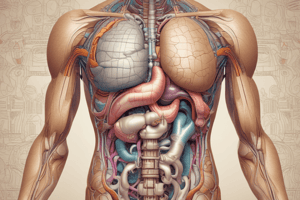Podcast
Questions and Answers
Which of the following are parts of the digestive tract?
Which of the following are parts of the digestive tract?
- Pancreas
- Oral cavity (correct)
- Esophagus (correct)
- Liver
The function of the digestive tract includes secretion of bile.
The function of the digestive tract includes secretion of bile.
True (A)
What is the main function of mastication?
What is the main function of mastication?
Chewing food into digestible pieces
Name the four main layers of the digestive tract.
Name the four main layers of the digestive tract.
What does the myenteric plexus primarily control?
What does the myenteric plexus primarily control?
What type of epithelium lines the oral cavity?
What type of epithelium lines the oral cavity?
The connective tissue in the vermilion zone of the lips is rich in ______.
The connective tissue in the vermilion zone of the lips is rich in ______.
The submucosa contains glands and lymphoid tissue.
The submucosa contains glands and lymphoid tissue.
Which type of tissue is primarily found in the hard palate?
Which type of tissue is primarily found in the hard palate?
Hirschsprung disease is a condition in which the plexuses in the digestive tract's ______ are absent.
Hirschsprung disease is a condition in which the plexuses in the digestive tract's ______ are absent.
Flashcards are hidden until you start studying
Study Notes
Digestive System
- Consists of the digestive tract (gastrointestinal (GI) tract or alimentary canal) and accessory digestive organs.
- The digestive tract includes the oral cavity, esophagus, stomach, small and large intestines.
- Accessory digestive organs include the salivary glands, liver, gallbladder, and pancreas.
Digestive Tract Functions
- Ingestion: introduction of food and liquid into the oral cavity.
- Mastication: dividing solid food into digestible pieces.
- Motility: muscular movements of materials through the tract.
- Secretion: secretion of mucus, digestive enzymes, acidic and alkaline fluids, and bile.
- Hormone release: for local control of motility and secretion.
- Chemical digestion: enzymatic degradation of large macromolecules in food to smaller molecules and their subunits.
- Absorption: of the small molecules and water into the blood and lymph.
- Elimination: of indigestible, unabsorbed components of food.
General Structure of the Digestive Tract
- The wall of the digestive tract has four main layers: mucosa, submucosa, muscularis, and serosa.
Mucosa
- Composed of epithelial lining, lamina propria, and muscularis mucosae.
- Epithelial lining: varies depending on the region of the digestive tract.
- Lamina propria: made up of loose connective tissue rich in blood vessels, lymphatics, lymphocytes, and smooth muscle cells.
- Muscularis mucosae: a thin layer of smooth muscle separating the mucosa from the submucosa.
Submucosa
- Contains denser connective tissue with many blood and lymph vessels.
- The submucosal (Meissner) plexus of autonomic nerves.
- May also contain glands and lymphoid tissue.
Muscularis
- Composed of inner circular and outer longitudinal smooth muscle cells.
- Contains blood and lymph vessels.
- Myenteric (Auerbach) nerve plexus: generates and coordinates contractions of the muscularis.
Serosa/Adventitia
- A thin sheet of loose connective tissue rich in blood vessels, lymphatics, and adipose tissue.
- Covered with a simple squamous covering epithelium or mesothelium.
Neural Innervation of GI Tract
- Enteric nervous system: extends from esophagus to anus and is grouped into two plexuses:
- Myenteric plexus (plexus of Auerbach): found between the longitudinal and circular layers of muscularis.
- Submucosal plexus (Meissner's plexus): found within the submucosa.
- Autonomic nervous system:
- Sympathetic NS: decreases GI function, motility, and secretions.
- Parasympathetic NS: increases GI function, motility, and secretions.
Medical Applications
- Hirschsprung disease (congenital aganglionic megacolon): plexuses in the digestive tract's enteric nervous system are absent.
- Chagas disease (trypanosomiasis, infection with the protozoan Trypanosoma cruzi): plexuses in the digestive tract's enteric nervous system are severely injured, disturbing digestive tract motility.
Oral Cavity
- Lined with stratified squamous epithelium, keratinized or nonkeratinized depending on the region.
- Keratin layer: protects the oral mucosa from damage during mastication.
- Nonkeratinized squamous epithelium covers the soft palate, cheeks, floor of the mouth, and pharynx.
Histology of Lips
- Has three zones:
- Inner zone: lining mucosa with a thick, nonkeratinized epithelium and many minor labial salivary glands.
- Outer zone: thin skin consisting of epidermal and dermal layers, sweat glands, and many hair follicles with sebaceous glands.
- Vermilion zone: covered by very thin keratinized stratified squamous epithelium, lacks salivary or sweat glands, and is kept moist with saliva from the tongue.
Hard and Soft Palate
- Separates the oral cavity from the nasal cavity.
- Nasal side: both palates covered by pseudostratified ciliated columnar epithelium with goblet cells and mixed glands.
- Oral side:
- Soft palate: non-keratinized stratified squamous epithelium.
- Hard palate: keratinized stratified squamous epithelium.
- Purely mucous glands.
Studying That Suits You
Use AI to generate personalized quizzes and flashcards to suit your learning preferences.




